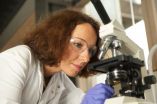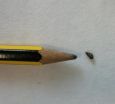(Press-News.org) Human and chimp brains look anatomically similar because both evolved from the same ancestor millions of years ago. But where does the chimp brain end and the human brain begin?
A new UCLA study pinpoints uniquely human patterns of gene activity in the brain that could shed light on how we evolved differently than our closest relative. Published Aug. 22 in the advance online edition of Neuron, these genes' identification could improve understanding of human brain diseases like autism and schizophrenia, as well as learning disorders and addictions.
"Scientists usually describe evolution in terms of the human brain growing bigger and adding new regions," explained principal investigator Dr. Daniel Geschwind, Gordon and Virginia MacDonald Distinguished Professor of Human Genetics and a professor of neurology at the David Geffen School of Medicine at UCLA. "Our research suggests that it's not only size, but the rising complexity within brain centers, that led humans to evolve into their own species."
Using post-mortem brain tissue, Geschwind and his colleagues applied next-generation sequencing and other modern methods to study gene activity in humans, chimpanzees and rhesus macaques, a common ancestor for both chimpanzee and humans that allowed the researchers to see where changes emerged between humans and chimpanzees. They zeroed in on three brain regions – the frontal cortex, hippocampus and striatum.
By tracking gene expression, the process by which genes manufacture the amino acids that make up cellular proteins, the scientists were able to search the genomes for regions where the DNA diverged between the species. What they saw surprised them.
"When we looked at gene expression in the frontal lobe, we saw a striking increase in molecular complexity in the human brain," said Geschwind, who is also a professor of psychiatry at the Semel Institute for Neuroscience and Behavior at UCLA.
While the caudate nucleus remained fairly similar across all three species, the frontal lobe changed dramatically in humans.
"Although all three species share a frontal cortex, our analysis shows that how the human brain regulates molecules and switches genes on and off unfolds in a richer, more elaborate fashion," explained first author Genevieve Konopka, a former postdoctoral researcher in Geschwind's lab who is now the Jon Heighten Scholar in Autism Research at University of Texas Southwestern Medical Center. "We believe that the intricate signaling pathways and enhanced cellular function that arose within the frontal lobe created a bridge to human evolution."
The researchers took their hypothesis one step further by evaluating how the modified genes linked to changes in function.
"The biggest differences occurred in the expression of human genes involved in plasticity – the ability of the brain to process information and adapt," said Konopka. "This supports the premise that the human brain evolved to enable higher rates of learning."
One gene in particular, CLOCK, behaved very differently in the human brain. Considered the master regulator of Circadian rhythm, CLOCK is disrupted in mood disorders like depression and bipolar syndrome.
"Groups of genes resemble spokes on a wheel – they circle a hub gene that often acts like a conductor," said Geschwind. "For the first time, we saw CLOCK assuming a starring role that we suspect is unrelated to Circadian rhythm. Its presence offers a potentially interesting clue that it orchestrates another function essential to the human brain."
When comparing the human brain to the non-human primates, the researchers saw more connections among gene networks that featured FOXP1 and FOXP2. Earlier studies have linked these genes to humans' unique ability to produce speech and understand language.
"Connectivity measures how genes interact with other genes, providing a strong indicator of functional changes," said Geschwind. "It makes perfect sense that genes involved in speech and language would be less connected in the non-human primate brains – and highly connected in the human brain."
The UCLA team's next step will be to expand their comparative search to 10 or more regions of the human, chimpanzee and maque brains.
INFORMATION:
Geschwind and Konopka's coauthors included Tara Friedrich, Jeremy Davis-Turak, Kellen Winden, Fuying Gao, Leslie Chen, Rui Luo, all of UCLA; Michael Oldham of UC San Francisco; Guang-Zhong Wang of the University of Texas Southwestern Medical Center; and Todd Preuss of Emory University.
The research was supported by grants from the National Institute of Mental Health (R37MH060233) and (R00MH090238); a NARSAD Young Investigator Award, the National Center for Research Resources (RR00165) and Office of Research Infrastructure Programs/OD (P51OD11132); and a James S. McDonnell Foundation grant (JSMF 21002093).
The UCLA Department of Neurology focuses on understanding the human nervous system and improving the lives of people living with diseases of the brain and nervous system. The UCLA Department of Human Genetics is dedicated to transforming raw genetic data into a detailed understanding of the molecular pathogenesis of human disease. UCLA Department of Psychiatry and Biobehavioral Sciences faculty are experts in the origins of and treatments for disorders of complex human behavior. The department is part of the Semel Institute for Neuroscience and Human Behavior, a world leading, interdisciplinary research and education institute devoted to the understanding of complex human behavior and the causes and consequences of neuropsychiatric disorders.
More sophisticated wiring, not just bigger brain, helped humans evolve beyond chimps
UCLA study could deepen understanding of human diseases
2012-08-22
ELSE PRESS RELEASES FROM THIS DATE:
Lack of food increases hospital use by HIV-infected urban poor in SF
2012-08-22
UCSF researchers found that poor HIV-infected individuals living in San Francisco are significantly more likely to visit emergency rooms and to have hospital stays if they lack access to food of sufficient quality and quantity for a healthy life.
"In the prior three months, a quarter of participants in the study reported an ER visit, and just over a tenth reported a hospitalization, which shows that we are dealing with a population with high levels of illness. But the food insecure people were even sicker than the food secure, which is consistent with their experiencing ...
Green tea compound shows promise for tackling cancer
2012-08-22
A compound found in green tea could be a weapon in treatments for tackling cancer, according to newly-published research at the University of Strathclyde in Glasgow, Scotland.
The extract, known as epigallocatechin gallate, has been known to have preventative anti-cancer properties but fails to reach tumours when delivered by conventional intravenous administration.
However, in initial laboratory tests at the Universities of Strathclyde and Glasgow, researchers used an approach which allowed the treatment to be delivered specifically to the tumours after intravenous ...
Glass offers improved means of storing UK's nuclear waste
2012-08-22
ILW makes up more than three quarters of the volume of material destined for geological disposal in the UK. (1)
Currently the UK's preferred method is to encapsulate ILW in specially formulated cement. The waste is mixed with cement and sealed in steel drums, in preparation for disposal deep underground.
Two studies, published in the latest issues of The Journal of Nuclear Materials and European Journal of Glass Science and Technology A show that turning this kind of waste into glass, a process called vitrification, could be a better method for its long-term storage, ...
Losing stream in our battle to predict and prevent invasive species
2012-08-22
Invasive species – plants, animals, and microbes introduced to regions beyond their native range – carry a global price tag of $1.4 trillion dollars. They are responsible for the loss of natural resources and biodiversity, damages to infrastructure, and an uptick in infectious diseases.
Not all non-native species pose a threat. Scientists around the world have spent the last several decades teasing apart the conditions that set the stage for debilitating invaders, like giant hogweed, zebra mussels, or gray squirrels. A number of hypotheses have emerged to help predict ...
Survival without water: A key trait of an aquatic invader to spread
2012-08-22
Nowadays, an increasing number of rivers and lakes are being invaded by exotic snails, which come from remote regions, and even other continents. Such species represent a threat to native species, as they compete for food or space with them.
This is the case of the mudsnail Potamopyrgus antipodarum. This small aquatic snail is native to New Zealand, and has spread throughout rivers, lakes or streams in Europe, Australia, America and Asia. The invasion success of this mudsnail may be partly due to the ability of females to reproduce without participation of males (i.e. ...
Scientists quantify nanofiber health risk to workers
2012-08-22
Health risks posed to people who work with tiny fibres used in manufacturing industries could be reduced, thanks to new research.
Research into the health risks posed by nanofibres – used to strengthen objects from tennis rackets to airplane wings – has pinpointed the lengths at which these fibres are harmful to the lungs.
Nanofibres, which can be made from a range of materials including carbon, are about 1,000 times smaller than the width of a human hair and can reach the lung cavity when inhaled.
This may lead to a cancer known as mesothelioma, which is known to ...
Thinking about kids? Man, you gotta shed the kilos
2012-08-22
Australian scientists studying the impact obesity has on pregnancy, are urging men to get 'match fit' before conceiving to assist with fetal development.
Reproductive experts from the University of Melbourne's Department of Zoology have discovered that a father's obesity negatively impacts sperm, resulting in smaller fetuses, poor pregnancy success and reduced placental development.
While the health risks surrounding obesity and pregnancy have largely been centred on overweight mothers, scientists from the University of Melbourne are putting the onus on men to shape ...
How to act if there is a fire on the AVE
2012-08-22
Researchers at the University of Cantabria have used computer models to analyse the best way to evacuate the Spanish High Speed Train, AVE, in the case of fire. The involvement of the crew in organising the fast transfer of passengers, completing the process before the train comes to a halt and collective collaboration to assist those with reduced mobility are just some of the strategies to be followed.
"In the event of fire on an AVE, two stages should be defined: the first is pre-evacuation in which passengers are transferred from one coach to another while the train ...
Male mice exposed to chronic social stress have anxious female offspring
2012-08-22
BOSTON (August 22, 2012) —A study in mice conducted by researchers at Tufts University School of Medicine (TUSM) suggests that a woman's risk of anxiety and dysfunctional social behavior may depend on the experiences of her parents, particularly fathers, when they were young. The study, published online in Biological Psychiatry, suggests that stress caused by chronic social instability during youth contributes to epigenetic changes in sperm cells that can lead to psychiatric disorders in female offspring across multiple generations.
"The long-term effects of stress can ...
MR enterography is option for pediatric patients with Crohn disease
2012-08-22
Parents with children nine years old and older who have Crohn disease should ask their children's doctor about MR enterography as a replacement for small bowel x-rays or CT enterography, a new study indicates.
Children with inflammatory bowel disease must often undergo repeated examinations, which, with x-rays and CT, could lead to significant radiation exposure, said William A. Faubion, Jr., MD, one of the authors of the study.
"MR enterography does not require any radiation, however the patient does have to drink an oral contrast agent, must hold their breath at times ...
LAST 30 PRESS RELEASES:
The perfect plastic? Plant-based, fully saltwater degradable, zero microplastics
Bias in data may be blocking AI’s potential to combat antibiotic resistance
Article-level metrics would provide more recognition to most researchers than journal-level metrics
Satiety’s little helper: Protein that supports appetite regulating protein identified
UF dives deep into predicting storm damage with computer models
A stormy ocean voyage yields insights on the global carbon cycle
Scientists identify first non-coding gene that controls cell size
Demonstration of altermagnetism in RuO₂ thin films -- A new magnetic material for the AI era
Penn researchers awarded $25M to conduct trial using smartphones to fight heart disease
PCORI awards funding for new patient-centered healthcare research
Exploring the origins of the universe: 145 low-noise amplifiers complete ALMA telescopes
Empress cicada wings help illuminate molecular structure
Using sound waves to detect helium
Time burden in patients with metastatic breast and ovarian cancer from clinic and home demands
Researchers discover bias in AI models that analyze pathology samples
Scientists ID potential way to prevent brain injuries from triggering Alzheimer's
MASTER 2nd Open Call: Execution period kick-off
Algae for health in food and pharma
Advanced microrobots driven by acoustic and magnetic fields for biomedical applications
Chicago health information leader recognized for raising CPR readiness and blood pressure awareness
The Intimate Animal, a new book from Kinsey Institute Executive Director Dr. Justin Garcia
When blue-collar workers lose union protection, they try self-employment
New video dataset to advance AI for health care
MEA-based graph deviation network for early autism syndrome signatures in human forebrain organoids
New modeling approach sheds light on rare gut disease
Study documents potentially hazardous flame retardants in firefighter gear
Can certain bacteria regulate aging of the immune system and its related alterations?
AI model helps diagnose often undetected heart disease from simple EKG
There are fewer online trolls than people think
Cell membrane fluctuations produce electricity
[Press-News.org] More sophisticated wiring, not just bigger brain, helped humans evolve beyond chimpsUCLA study could deepen understanding of human diseases




